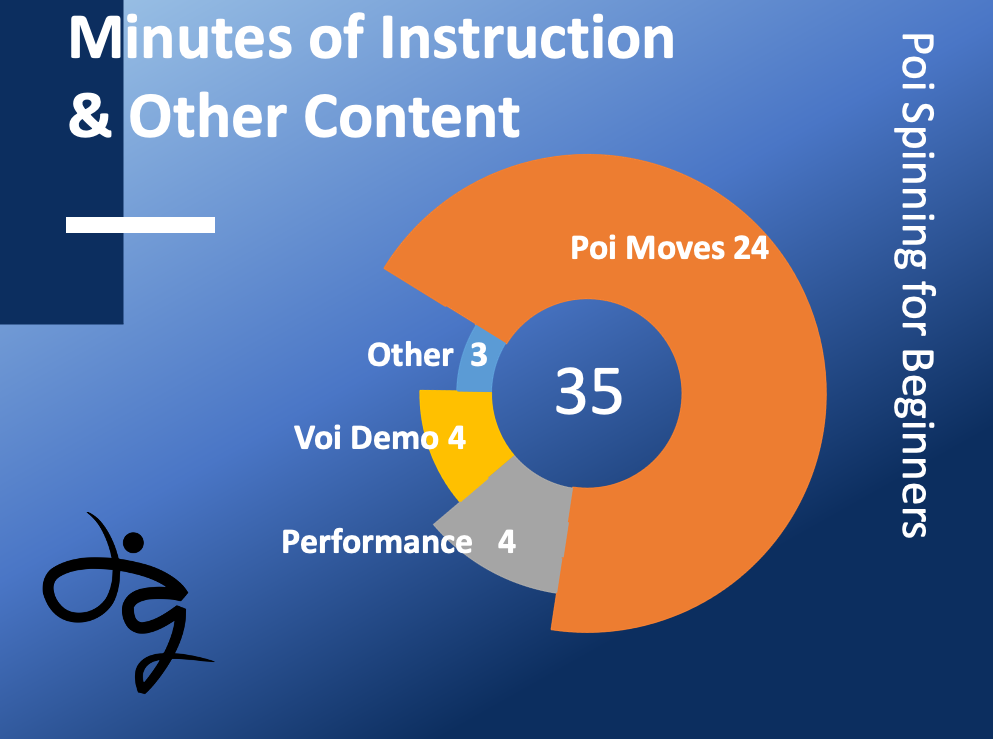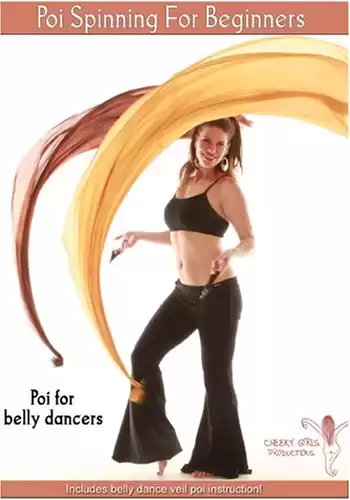Michelle Joyce teaches about 8 poi patterns using slow motion video demonstrations as well as at full speed. Some technique pointers are given for adapting the poi moves to voi. This is mostly a try to copy the teacher’s movements video, which beginners may find frustrating. The poi and voi moves aren’t layered with belly dance moves, which intermediate and advanced dancers would prefer.
If you are a new belly dancer, you might want to work on your arm and hand movement technique and skills before trying veil poi. You need to be able to dance with fluid arm and hand movements before adding voi veils, which are another layer of physical and mental coordination. The motion of the poi is mostly controlled by your wrists. It’s easy to get the poi moving, but it takes time and practice to gain control of the poi.
Teaches about 8 poi patterns using slow motion video demonstrations as well as at full speed. Some technique pointers are given for adapting the poi moves to voi.
Michele is filmed in front of a mirror, so you can see the moves from both the front and back. Each move taught in segments and includes slow motion video. The poi moves start out simple and go to advanced. She wears a simple, non-distracting outfit of black yoga tights and crop top with a beautiful metal necklace. Michelle’s poi spinning technique is excellent. The poi moves are clear, not muddled. She demonstrates some of the poi moves using the belly dance camel movements.
The instruction starts with a quick over view of the different types of poi with some of their pros and cons. This is followed by her naming the moves she’ll teach as she demonstrates the moves. This gives you a visual idea of what you will learn in her course. The poi and voi moves you’ll learn are:
- Butterfly
- Butterfly turns
- Mexican wave
- Other butterfly combinations
- High and low turns both traveling and in place
- Corkscrew
- Chasing the sun
- Triple circle
- Split triple circle
- Weave (static and turning)
- Windmill
Skill Focus Time Breakdown Infographic
Poi Spinning for Beginners is 35 minutes long. The following infographic is an approximate breakdown of how many minutes are included in the DVD for various belly dance skills.

Forward Spin
She first explains the forward spin, which is the simplest poi move. During the forward spin the poi are going forward. The poi travel from up to down. You should make sure your wrists are making full rotations or the poi will look lopsided. The poi should rotate in your side plane outside of your body.
Butterfly
The next poi move taught, is the butterfly during which the poi spin inwards in the frontal plane. Palms are facing upward and hands are close together. The right hand should be on top and slightly forward of the left hand to keep the poi from getting tangled. You should use your wrists to guide the poi in flat, even circles. Practice passing one poi behind your head. Make sure your palm is up when you pass the poi behind your head. Visualize the poi making a giant figure 8 in front and behind you.
Mexican Wave
If you spin the poi so there is one beat in between passing the alternating poi behind your head, it’s called the Butterfly. With no beats in between, it’s the Mexican Wave.
High and Low Turns
The high and low turn move is taught to help you change directions by using a 180 degree turn. With the poi going forward you can turn by passing the poi behind your back when the poi are at the bottom of the circle. Once you turn, the poi are traveling backward. To go back to forward, simply slow the poi down and reverse their direction. Pausing the poi to reverse directions is called a stall.
She next explains how this turn is easiest to learn this move and most moves is by using only one poi at a time. Michelle explains using the high and low moves while turning, traveling, and in place. We found this turn to be pretty intuitive to learn.
Butterfly Variations
She next teaches a few Buttery poi variations as follows:
- Passing both poi behind your head while you dip down in what is like a squat move. This level change will be difficult if you are not physically strong and flexible.
- Extending the arms fully on the outside of the butterfly rotation. This extension can be done with both arms at the same time or with one arm at a time. With the one arm variation, the non-extended arm has to do two poi rotations while waiting for the extended arm. This is a 2-to-1 timing.
- Reversing the poi to travel outward, which is the Reverse Butterfly.
Triple Circle
The next move taught is the Triple Circle, which starts in the reverse butterfly. You perform two circles in the back and one in the front. The circle in the front should be slow and the two in the back quicker to get a 2-to-1 timing. We found this move required a practice to get our arms to move at two different speeds. It’s natural to want to move both poi at the same speed.
Butterfly Turns
Butterfly Turns are turning while doing the Butterfly poi pattern. As crazy as it sounds, when you turn 90 degrees to the right doing the butterfly, you’ll have one poi spinning forward and one spinning backward. If you turn another 90 degrees, then both poi are spinning backwards. If you turn a 3rd 90 degrees, then one poi is spinning forward and one backward again. If you turn 90 degrees once again to complete a 360 degree turn, both poi will be spinning forward again. Or if you turn 90 degrees to the right and the 90 degrees to the left, both poi will be spinning forward again. Don’t overthink it. Just let the poi direction changes happen.
Split Butterfly
She teaches the Split Butterfly where you alternate between passing the poi behind your head and behind your back.
Chasing the Sun
The next poi move taught is Chasing the Sun. From a forward spin you circle both poi in front of you and then behind your head. It looks like the poi are following or chasing each other. This move can be done in a stationary position or when traveling.
Corkscrew
For the Corkscrew, the poi must be shorter than your arms. You can wrap the poi leash around your hand to shorten the poi. This move is more complicated because you have to figure out how to wrap and unwrap the poi leashes while dancing, which she doesn’t explain how to do.
Weave
The last move taught is the Weave, which is an advanced move that takes lots of practice. In fact, we’re still working on it. It’s a beautiful poi move with a 3 beat rhythm. It’s best to learn using one poi in the right hand. The right hand poi first circle over and under the left hand then out to the right side. The wrists are together. The left hand is making an over, under, out pattern. Then practice with just a poi the left hand. Practice until you have the move using each single poi in muscle memory. The hands are like doing lotus hands with no poi. If extending the arms during this move, you can do a barrel turn.
Veil Poi or Voi
First, Michelle covers how to make a veil poi. She demonstrates how you can disguise the veil poi as double veils when entering the stage by holding the poi ends in your hands. All of the moves taught previously can be done with veil poi, including the weave and the corkscrew.
However, with veil poi, the long veils can get tangled, so it is best to learn the moves with poi before moving to voi. Michelle gives tips on how to avoid getting the veils tangled. The veils tend to get tangled in the Butterfly patterns. She shows the veil moves in slow motion. Michelle gives very little instruction about the voi movements. You have to just try the poi moves while holding the voi.
Performance
Michelle performs a veil poi routine in a modern, red cabaret outfit to a modern Egyptian pop ballad. Her performance is well choreographed. However, she uses very few actual belly dance moves, it’s all about the voi.
Music Used
The following is the music used in the Michelle Joyce’s Poi Spinning for Beginners DVD for her veil poi performance.
- Singer Farah Ibrihim and keyboardist Elias Ishmawi. This music is not available on Amazon.
Dancer Skill Level – Beginner
This video is suitable for beginner dancers as no real dance skills are required. A non-dancer or a non-belly dancer could also use this instructional video to learn poi moves as no belly dance moves are layered with the poi moves. Some of the moves, such as the Weave, may be too advanced for someone with no poi spinning experience. There is a steep learning curve with poi and voi. By stringing all the poi moves taught together can make an entire poi routine
DVD Review Rating – 3.3 Stars
We give this video a rating of 3.3 stars because there is no detailed technique explanations given for the poi moves. A dancer mostly has to try and copy the moves that Michelle is performing. The slow motion video of the poi moves help, but there are a lot of arm, hand, and wrist movements to try to copy. She does demonstrate how using one poi at a time can make moves easier to learn. We found it hard to determine which of the poi moves taught she was doing with the voi. Maybe it was because we were beginners and weren’t familiar enough with the moves.
Teaches about 8 poi patterns using slow motion video demonstrations as well as at full speed. Some technique pointers are given for adapting the poi moves to voi.
Poi Spinning for Beginners

Teaches about 8 poi patterns using slow motion video demonstrations as well as at full speed. Some technique pointers are given for adapting the poi moves to voi.
3.3

